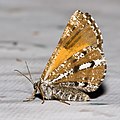| Bordered white | |
|---|---|
 | |
| Upperwings of adult male of a southern population | |
| Scientific classification | |
| Kingdom: | Animalia |
| Phylum: | Arthropoda |
| Class: | Insecta |
| Order: | Lepidoptera |
| Family: | Geometridae |
| Genus: | Bupalus |
| Species: | B. piniaria |
| Binomial name | |
| Bupalus piniaria | |
| Synonyms [1] | |
List
| |
The bordered white or pine looper (Bupalus piniaria), is a moth of the family Geometridae. Among these, it belongs to tribe Bupalini of the subfamily Ennominae. B. piniaria is a common species throughout the western Palearctic region, the Near East and North Africa. However, its presence in certain regions – e.g. the northern Balkans – is doubtful. [2] East it is found to Siberia and Amur Oblast.
Contents
Three subspecies are generally recognized, while two additional ones are doubtfully distinct: [3]
- Bupalus piniaria bernieride Lajonquiere, 1958
- Bupalus piniaria espagnolusEitschberger & Steiniger, 1975
- Bupalus piniaria flavescensWhite, 1876 (usually included in piniaria)
- Bupalus piniaria mughusariaGumppenberg, 1887 (usually included in piniaria)
- Bupalus piniaria piniaria(Linnaeus, 1758)
In addition, many forms (e.g. kolleri) have also been named. [4] [5]











